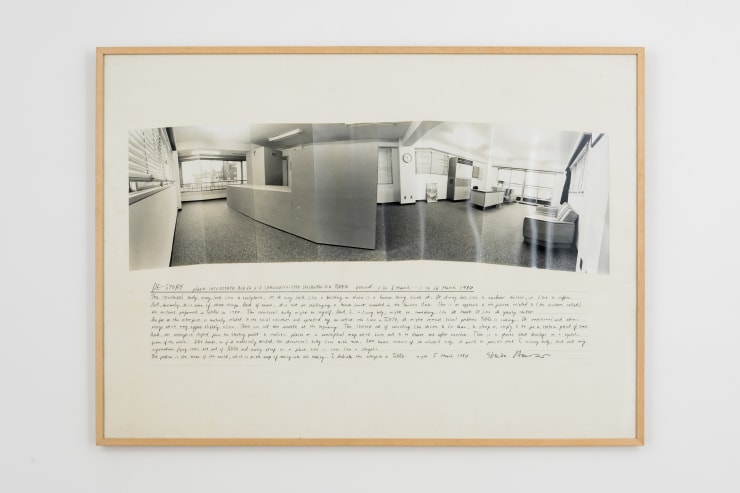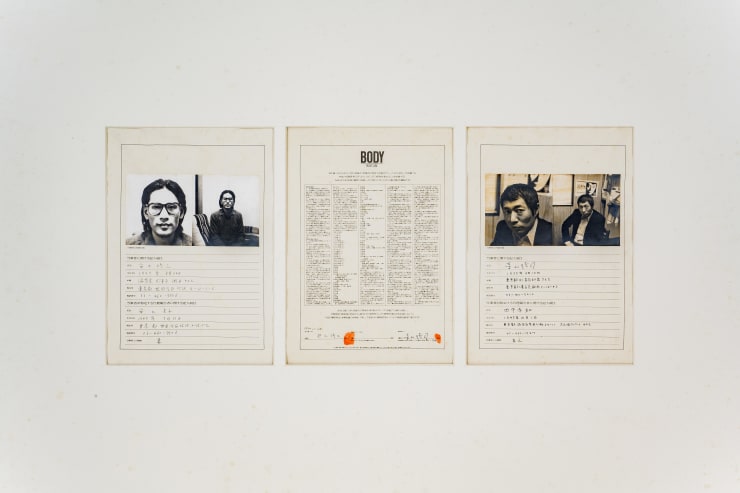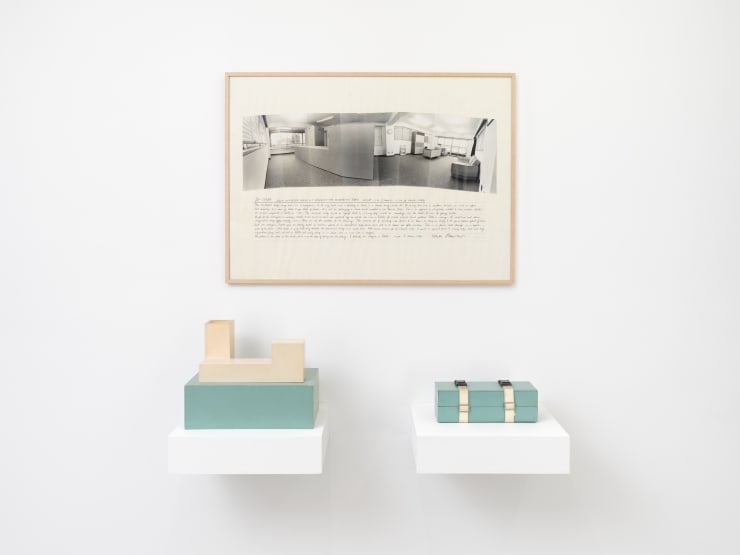SHUZO AZUCHI GULLIVER: ‘Synogenesis’
Nonaka-Hill Gallery is delighted to present SHUZO AZUCHI GULLIVER ‘Synogenesis’, which marks Azuchi’s first West Coast solo exhibition, encompassing multimedia works spanning from 50 years of the artist's dynamic career.
In 1963, after finding a book on the works of Marcel Duchamp, written entirely in French -Shuzo Azuchi was inspired by the liberating qualities he saw in the works, prompting him to commence his first Happenings in highschool. Staging performances such as, Grassfields (1963), in which 9 performers weeded a 9m x 9m plot of the schoolyard, while viewers watched from the roof.
In 1967, Azuchi studied philosophy at Ritsumeikan University, during this time Azuchi met international members of Fluxus, picking up the nickname “Gulliver,” and leading him to broaden his artistic practice with developments in expanded cinema. Using his own body as a reference point, Azuchi charts the bodily relation to space, time, and empirical data. The influence of Duchamp retained in Azuchi’s documentary approach to artistic production. Cataloging both the physical and intangible world (space, sound) and calling to question the necessary structures (organic and constructed) which define us.
Weight (Human Ball) (1978), part of a larger body of work in which the artist creates a stainless steel ball recording his weight at the time of its production, documenting, cataloging and superimposing the artist's physical mass within the context of a given time - while the polished surface of the ball reflects the surrounding world. The object rests on a sofa - its weight imprinting on the cushion providing a placeholder for the artist’s physical presence. The later work, Weight (Human Ball) (2022), again documents the artist's weight at the time of production, now presenting a slightly heavier mass. The series provides a comprehensive chart documenting the artist's physical presence in the world over a period of time.
Focusing on the ideological concept of the body, Azuchi’s ongoing BODY (1973-) project, formulates a contract entrusting 80 individuals to 80 parts of the artist's posthumous body. The contract, structured as a legal agreement, lists each of the 80 pieces of Azuchi’s body utilizing spatial designation (right/left), names, numbers, and signs ‘A’, ‘B’, ‘C’ as symbols for the respective parties. The work not only breaks down the physical composition of the body, but in the process of producing the contract - each party recognizes and confirms the existence of the other. Each of the 80 pieces are intended to become preserved as art objects after the artist's death.
While the analytic mapping of the flesh reiterates the artist's larger play on the physical body's spatial presence, it also introduces Azuchi’s larger exploration into contracts (signs and meanings) which define language, understanding, and provide the foundation for empirical knowledge.
During the 1984 performance De-Story, Azuchi enclosed himself within a geometric structure composed of measurements necessary for the artist to sit, stand, and lie. Confined in the space for 10 days (a total of 240 hours). A speaker attached to the tall ‘stand’ section, projects the rhythm of the artist's heartbeat - recalling the coporality of the being inside the structure. Small “De-Story” (1984), documents this work, reformulating it into a model fit for a goldfish. Presented alongside the relic Foodbox for “De-Story” (1984), the original bento-box used to serve the artist food 3 times a day during the 10 day performance. While these works chart a spatial trajectory of the physical body, they recognize the body as a structure which grounds it into the world.
Azuchi’s work also extends beyond bodily observation. Interested in how each living form is composed of four elements, (A=Adenine, T=Thymine, C=Cytosine, G=Guanine), making up the genetic material DNA. Azuchi repeats patterns for genetic coding in works such as Body/ A.T.C.G (1993), printing the ‘ATCG’ coding upon a piece of paper and delicately clipping it upon a hanger - in a shape reminiscent of the human figure.
Although Azuchi’s body of work is far ranging, they call to attention the necessary structures fundamental to life - whether that be the physical body, the structuring of language as an agreement of sounds, symbols and their meanings, or the construct of time. Azuchi’s cataloging of the world provides not only a humorous perspective on the nature of reality, but also a method in the search of meaning and truth.
Shuzo Azuchi ‘Gulliver’ (b. 1947; Shiga Prefecture, Japan). Shuzo Azuchi Gulliver lives and works in Tokyo, Japan. Selected solo exhibitions include Breath-Amorphous (2022) BankArt, Yokohama (Japan); Cinematic Illumination (2020) Museum of Moderm Art (United States); La dolce vita (1999/2015) (2015) Neue Kunstverein Wuppertal, Wuppertal (Germany); Shuzo Azuchi Gulliver (2009), Dieci.Due Arte, Milano (Italy). Permanent installations and public/museum collections include Shiga Museum of Art (Shiga, Japan); The National Museum of Modern Art, Kyoto (Kyoto, Japan); Tokyo Photographic Art Museum (Tokyo, Japan); Museum of Modern Art (New York, United States).
 Shuzo Azuchi GulliverThree colored pencils (Document) #1-Hairs, 1975Hairs, photograph, typing and pencil on paper16 3/4 x 13 5/8 in
Shuzo Azuchi GulliverThree colored pencils (Document) #1-Hairs, 1975Hairs, photograph, typing and pencil on paper16 3/4 x 13 5/8 in
42.4 x 34.7 cm Shuzo Azuchi GulliverThree colored pencils (Document) #2-Blood, 1975Blood, photograph, typing and pencil on paper16 3/4 x 13 5/8 in
Shuzo Azuchi GulliverThree colored pencils (Document) #2-Blood, 1975Blood, photograph, typing and pencil on paper16 3/4 x 13 5/8 in
42.4 x 34.7 cm Shuzo Azuchi GulliverThree colored pencils (Document) #3-Feces, 1975Feces, photograph, typing and pencil on paper16 3/4 x 13 5/8 in
Shuzo Azuchi GulliverThree colored pencils (Document) #3-Feces, 1975Feces, photograph, typing and pencil on paper16 3/4 x 13 5/8 in
42.4 x 34.7 cm Shuzo Azuchi GulliverThree colored pencils (first plan), 1974-75Print on paper, wooden frameLeft: 18 1/8 x 7 3/4 in (46 x 19.8 cm)
Shuzo Azuchi GulliverThree colored pencils (first plan), 1974-75Print on paper, wooden frameLeft: 18 1/8 x 7 3/4 in (46 x 19.8 cm)
Right: 18 1/8 x 9 in (46 x 22.9 cm) Shuzo Azuchi GulliverThree colored pencils : Model-D, 1975Mixed media9 7/8 x 15 3/4 x 4 in
Shuzo Azuchi GulliverThree colored pencils : Model-D, 1975Mixed media9 7/8 x 15 3/4 x 4 in
25 x 40 x 10 cm Shuzo Azuchi GulliverPre-work for 'The Metal Having the Length', 1976-78 (reconstructed 2023)Installation, mixed mediaDimensions variable
Shuzo Azuchi GulliverPre-work for 'The Metal Having the Length', 1976-78 (reconstructed 2023)Installation, mixed mediaDimensions variable Shuzo Azuchi GulliverSketch for 'Metal Having the Length', 1979Stamp and pencil on paper43 x 31 in
Shuzo Azuchi GulliverSketch for 'Metal Having the Length', 1979Stamp and pencil on paper43 x 31 in
109.1 x 78.8 cm Shuzo Azuchi GulliverLa dolce vita / A.T.C.G.(reality is sweet), Kyoto version, 2004Mixed media13 3/8 x 10 5/8 x 4 3/4 in
Shuzo Azuchi GulliverLa dolce vita / A.T.C.G.(reality is sweet), Kyoto version, 2004Mixed media13 3/8 x 10 5/8 x 4 3/4 in
34 x 27 x 12 cm Shuzo Azuchi GulliverDe-story : Paper piece #4, 1984Photograph and pencil on paper31 x 43 in
Shuzo Azuchi GulliverDe-story : Paper piece #4, 1984Photograph and pencil on paper31 x 43 in
78.8 x 109.1 cm Shuzo Azuchi GulliverSmall "De-story" structure for goldfish, 1984Mixed media13 5/8 x 17 3/8 x 10 1/4 in
Shuzo Azuchi GulliverSmall "De-story" structure for goldfish, 1984Mixed media13 5/8 x 17 3/8 x 10 1/4 in
34.5 x 44 x 26 cm Shuzo Azuchi GulliverFood box for "De-story", 1984Mixed media4 7/8 x 14 x 4 3/8 in
Shuzo Azuchi GulliverFood box for "De-story", 1984Mixed media4 7/8 x 14 x 4 3/8 in
12.5 x 35.5 x 11 cm Shuzo Azuchi GulliverWeight (Human Ball), 1978Stainless steel, wood, cottonBall: 9 3/8 in diameter (23.8 cm diameter), 64 kg
Shuzo Azuchi GulliverWeight (Human Ball), 1978Stainless steel, wood, cottonBall: 9 3/8 in diameter (23.8 cm diameter), 64 kg Shuzo Azuchi GulliverWeight (Human Ball), 2022Mixed mediaBall: 355mm (diameter), 75kg
Shuzo Azuchi GulliverWeight (Human Ball), 2022Mixed mediaBall: 355mm (diameter), 75kg Shuzo Azuchi GulliverSketch of human-ball #3-1, 1977Collage and pencil on paper13 3/4 x 16 5/8 in
Shuzo Azuchi GulliverSketch of human-ball #3-1, 1977Collage and pencil on paper13 3/4 x 16 5/8 in
34.8 x 42.3 cm Shuzo Azuchi GulliverSketch of human-ball #1-1, 1977Collage and pencil on paper13 3/4 x 16 5/8 in
Shuzo Azuchi GulliverSketch of human-ball #1-1, 1977Collage and pencil on paper13 3/4 x 16 5/8 in
34.8 x 42.3 cm Shuzo Azuchi GulliverDiscourse on Shosoku, 1983-86Mixed media9 5/8 x 47 1/4 x 23 5/8 in
Shuzo Azuchi GulliverDiscourse on Shosoku, 1983-86Mixed media9 5/8 x 47 1/4 x 23 5/8 in
24.5 x 120 x 60 cm Shuzo Azuchi GulliverBody / A.T.C.G., 1993/2000Mixed media39 3/8 x 16 7/8 x 4 in
Shuzo Azuchi GulliverBody / A.T.C.G., 1993/2000Mixed media39 3/8 x 16 7/8 x 4 in
100 x 43 x 10 cm
Unique Shuzo Azuchi GulliverBody : contract #54 / Shuji Terayama, 1974Mixed media43 x 64 1/4 in matted
Shuzo Azuchi GulliverBody : contract #54 / Shuji Terayama, 1974Mixed media43 x 64 1/4 in matted
109.2 x 163 cm matted Shuzo Azuchi GulliverBody: contract #76/Akaji Maro, 1974Paper, wood frameframed: 35 1/4 x 47 1/4 in
Shuzo Azuchi GulliverBody: contract #76/Akaji Maro, 1974Paper, wood frameframed: 35 1/4 x 47 1/4 in
89.6 x 119.9 cm Shuzo Azuchi GulliverBody : contract #2 / Minoru Yoshida, 1974Mixed media35 1/4 x 47 1/4 in framed
Shuzo Azuchi GulliverBody : contract #2 / Minoru Yoshida, 1974Mixed media35 1/4 x 47 1/4 in framed
89.6 x 119.9 cm framed Shuzo Azuchi GulliverBody : contract #58 / Masahisa Fukase, 1974Mixed media35 1/4 x 47 1/4 in framed
Shuzo Azuchi GulliverBody : contract #58 / Masahisa Fukase, 1974Mixed media35 1/4 x 47 1/4 in framed
89.6 x 119.9 cm framed Shuzo Azuchi GulliverBody : contract #80 / Daido Moriyama, 1974Mixed media35 1/4 x 47 1/4 in framed
Shuzo Azuchi GulliverBody : contract #80 / Daido Moriyama, 1974Mixed media35 1/4 x 47 1/4 in framed
89.6 x 119.9 cm framed Shuzo Azuchi GulliverI want to be here, (1985-) 2022Mixed media7 7/8 x 19 3/4 x 4 3/4 in
Shuzo Azuchi GulliverI want to be here, (1985-) 2022Mixed media7 7/8 x 19 3/4 x 4 3/4 in
20 x 50 x 12 cm Shuzo Azuchi GulliverSeven concurrents (New York version), 2020Mixed media11 3/4 x 28 3/8 in
Shuzo Azuchi GulliverSeven concurrents (New York version), 2020Mixed media11 3/4 x 28 3/8 in
30 x 72 cm Shuzo Azuchi GulliverAbout bed: a, 1995Print and colored pencil on paper13 3/4 x 16 3/4 in
Shuzo Azuchi GulliverAbout bed: a, 1995Print and colored pencil on paper13 3/4 x 16 3/4 in
34.9 x 42.4 cm
Related artist
Artist Exhibited:
Ulala Imai
Kazuo Kadonaga
Kentaro Kawabata
Zenzaburo Kojima
Kisho Kurokawa
Tadaaki Kuwayama
Toshio Matsumoto
Keita Matsunaga
Yutaka Matsuzawa
Kimiyo Mishima
Kunié Sugiura
Takuro Tamayama
Tiger Tateishi
Sofu Teshigahara
Shomei Tomatsu
Wataru Tominaga
Hosai Matsubayashi XVI
Kansuke Yamamoto
Masaomi Yasunaga
Exhibitions:
-2025-
Sea of Mud, Wall of Flame: Satoru Hoshino and Masaomi Ysunaga
KEY HIRAGA: The Elegant Life of Mr. H
-2024-
KYOKO IDETSU: What can an ideology do for me?
KENTARO KAWABATA / BRUCE NAUMAN
SAORI (MADOKORO) AKUTAGAWA: CENTENARIA
Keita Matsunaga : Accumulation Flow
-2023-
NONAKA-HILL ♥ TATAMI ANTIQUES: A holiday sale of unique objects from Japan
TAKASHI HOMMA : REVOLUTION No.9 / Camera Obscura Studies
TATSUMI HIJIKATA THE LAST BUTOH: Photographs by Yasuo Kuroda
Kiyomizu Rokubey VIII: CERAMIC SIGHT
Masaomi Yasunaga: 石拾いからの発見 / discoveries from picking up stones
SHUZO AZUCHI GULLIVER ‘Synogenesis’
Koichi Enomoto: Against the day
Tatsuo Ikeda / Michael E. Smith
Hiroshi Sugito: the garden with Zenzaburo Kojima
Zenzaburo Kojima: This very green
Tomohisa Obana: To see the rainbow at night, I must make it myself
Daisuke Fukunaga: Beautiful Work
- 2021 -
Natsuyasumi: In the Beginning Was Love
Takashi Homma: mushrooms from the forest
– 2020 –
Hosai Matsubayashi XVI & Trevor Shimizu
Sterling Ruby and Masaomi Yasunaga
– 2019 –
A show about an architectural monograph
Yutaka Matsuzawa
Yutaka Matsuzawa through the lens of Mitsutoshi Hanaga
Takuro Tamayama & Tiger Tateishi
Kunié Sugiura
Masaomi Yasunaga
Miho Dohi
Wataru Tominaga
Naotaka Hiro
Parergon: Japanese Art of the 1980s and 1990s
Tadaaki Kuwayama
– 2018 –
Toshio Matsumoto
Kentaro Kawabata
Kansuke Yamamoto
Kazuo Kadonaga: Wood / Paper / Bamboo / Glass
Press:
-2025-
ARTFORUM, Sawako Goda
Artillery Magazine, Sawako Goda
-2024-
Artsy, Nonaka-Hill
Richesse, Nonaka-Hill Kyoto
Bijutsutecho, Nonaka-Hill Kyoto
The Art Newspaper, Nonaka-Hill Kyoto
Meer, Kyoko Idetsu
Bijyutsutecho, Masaomi Yasunaga
Switch, Masaomi Yasunaga
ARTnews JAPAN, Masaomi Yasunaga
Richesse, Masaomi Yasunaga
Art Basel, Daisuke Fukunaga, Imai Ulala
Art Basel, Kazuo Kadonaga, Sofu Teshigahara
-2023-
ADF webmagazine, Yasuo Kuroda, Tatsumi Hijikata
e-flux, Sanya Kantarofsky, Yasuo Kuroda
Los Angeles Times, Kenzi Shiokava
Artillery, Masaomi Yasunaga
Contemporary Art Daily Shuzo Azuchi Gulliver
- 2022 -
Contemporary Art Daily, Tomohisa Obana
ARTE FUSE, Daisuke Fukunaga
Contemporary Art Daily, Daisuke Fukunaga
Contemporary Art Review Los Angeles (Carla), Daisuke Fukunaga
What's on Los Angeles, Daisuke Fukunaga
Hyperallergic, Daisuke Fukunaga
Artillery, Kentaro Kawabata
Larchmont Buzz, entaro Kawabata
- 2021 -
Art Viewer, Natsuyasumi: In the Beginning Was Love
Hyperallergic, Natsuyasumi: In the Beginning Was Love
Art Viewer, Takashi Homma
Hyperallergic, Busy Work at Home
Art Viewer, Busy Work at Home
Hyperallergic, Ulala Imai
Contemporary Art Review Los Angeles (Carla), Ulala Imai
Contemporary Art Daily, Ulala Imai
artillery, Ulala Imai
Special Ops, Ulala Imai
Art Viewer, Ulala Imai
artillery, Matsubayashi & Trevor Shimizu
– 2020 –
Ceramic Now, Sterling Ryby and Masaomi Yasunaga
Hypebeast, Sterling Ryby and Masaomi Yasunaga
Art Viewer, Sterling Ruby and Masaomi Yasunaga
Air Mail, Sterling Ruby and Masaomi Yasunaga
Los Angeles Times, Kaz Oshiro
ArtnowLA, Kaz Oshiro
What's on Los Angeles, Kaz Oshiro
KCRW, Kaz Oshiro
Tique, Kaz Oshiro
Contemporary Art Daily, Kaz Oshiro
Art Viewer, Kaz Oshiro
Contemporary Art Daily, Sofu Teshigahara
Art Viewer, Sofu Teshigahara
KCRW, Sofu Tsshigahara
Hyperallergic, Nonaka-Hill
Los Angeles Times, Keita Matsunaga
– 2019 –
Los Angeles Times, Tatsumi Hijikata
Art Viewer, Tatsumi Hijikata, Eikoh Hosoe
Contemporary Art Review Los Angeles, Tatsumi Hijikata, Eikoh Hosoe
ArtAsiaPacific, Yutaka Matsuzawa
Los Angeles Times, Tatsumi Hijikata
AUTRE, Tatsumi Hijikata, Eikoh Hosoe
Los Angeles Times, Nonaka-Hill
ARTFORUM, Takuro Tamayama, Tiger Tateishi
Art Viewer, Takuro Tamayama, Tiger Tateishi
KCRW, Nonaka-Hill
LA WEEKLY, Nonaka-Hill
AUTRE, Takuro Tamayama, Tiger Tateishi
ArtsuZe, Takuro Tamayama, Tiger Tateishi
ARTFORUM, Review: Tadaaki Kuwayama, Rakuko Naito
Art Viewer, Masaomi Yasunaga, Kunié Sugiura
Los Angeles Times, Masaomi Yasunaga
KQED, Tadaaki Kuwayama, Rakuko Naito
Contemporary Art Daily, Naotaka Hiro, Wataru Tominaga, Miho Dohi
Los Angeles Times, Miho Dohi
Los Angeles Review of Books, Miho Dohi
Bijutsu Techo, Naotaka Hiro, Wataru Tominaga, Miho Dohi
Art Viewer, Miho Dohi
Art & Object, Parergon
COOL HUNTING, Felix Art Fair
Art Viewer, Tadaaki Kuwayama
artnet news, Nonaka-Hill
Contemporary Art Review Los Angeles (Carla), Tadaaki Kuwayama
– 2018 –
Art Viewer, Kentaro Kawabata
Contemporary Art Daily, Kazuo kadonaga
Los Angeles Times, Kazuo Kadonaga
ARTFORUM, Kazuo Kadonaga
Contemporary Art Daily, Shomei Tomatsu
KCRW, Kimiyo Mishima, Shomei Tomatsu
This website uses cookies
This site uses cookies to help make it more useful to you. Find out more about cookies.

































